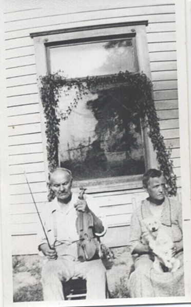One of the more interesting artifacts in the Museum is a 1936 violin, hand crafted from materials salvaged from the 1859 Clay County courthouse. This, the second courthouse in Clay County, was razed in 1934 to be replaced by a WPA project, with the county’s current edifice. Originally, court was conducted in the Owen’s Tavern, which stood at the northwest corner of Water and Mill Streets, while a courthouse could be planned and then built in 1831. The Statue of Justice is another relic saved in 1934 and now resides on the upper floor of the courthouse along with its history.
But, back to the violin. N. H. Ferguson was a “fiddle” man. He lived and farmed both in Ray and Clay Counties; and he played the fiddle. A worn “chin scarf” shows years of service, tucked between Nin and the fiddle as he played.


The Museum’s intern, John Paul Ridder, rediscovered the violin on the music shelf and was intrigued by its past. He did some research on the maker, Nin, and found the picture below of Nin, his wife, Lizzy, and his fiddle. Determined to share his knowledge, John Paul created a new display to show off the violin and other pieces saved from the old courthouse. It stands on the first floor in the center of the room. He went a step further; on his own he contacted a violin repair shop and Bill Steel of Bill’s Violin Shop (pictured above with two violins) is now refurbishing Nin’s creation as a donation to the Museum. The second violin, in Bill’s right hand in the above picture, is the Ford Family violin – Robert Ford’s family – you know, “the dirty little coward, who shot Mr. Howard and laid poor Jesse in his grave.” Bill will also rehab this piece. In his professional opinion, Nin’s violin/fiddle will be playable once he’s done. And the Ford violin will be restored to its former glory.

Ninian Hannah “Nin” Ferguson was born in the Orrick Township in Ray County Missouri in 1870. He passed away at the age of 66 and is buried in Little Shoal Cemetery. Shortly before he died, he was featured in the Liberty Chronicle, 1936, for making a fiddle from reclaimed wood off the 1934 Clay County courthouse. Ninian was shot by his son-in-law, John H. Wubbenhorst. Ninian’s son Clarence fired at his father’s assailant, also his brother-in-law, and Wubbenhorst died the following day. Apparently, no charges were made against Clarence.
Nin married Elizabeth Rebecca “Lizzy” Black in 1891 and had five children: Alice Agnese, William Joseph, Pauline, Clarence Marvin and Edward Glenn. The couple’s third child, Pauline married John Herman Wubbenhorst of Liberty at the age of 15; they were married for 23 years and had 12 children. After Ninian’s death Lizzy moved to California and lived with her sons until her death in 1951. (Find-a-Grave via Ancestry.com)
Chery Carr Holtman, curator, Clay County Museum
